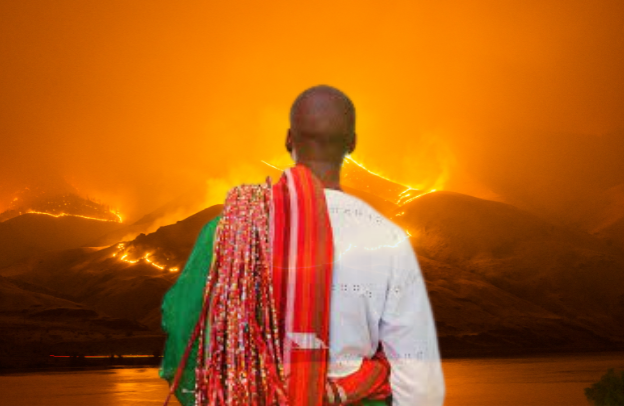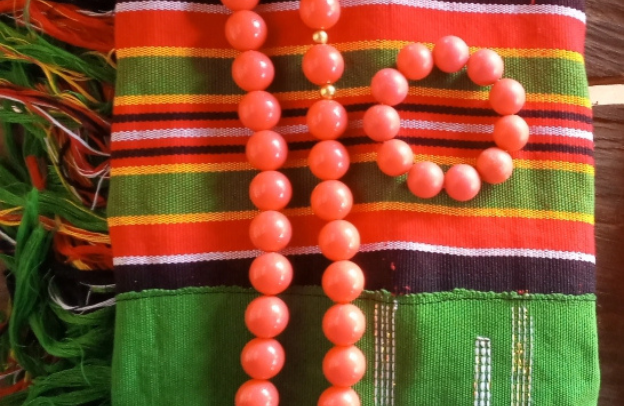The Esan, Bini War Of 1502 To 1503 (Agba: The Esan God Of War, 2)

Welcome to part two of our series: Agba, the Esan God of war. In this part of the series, we will examine the Esan – Bini War Of 1502 to 1503. Agba N’Ojie also referred to as “the Esan God of War”, held the position of the ruler of the Uromi people from 1483 AD to his death in 1503 AD. As an influential Onojie or king of Uromi, he played a crucial role in the history of the Esan people, leading them to stand up for themselves against the unfair domination by the Benin Oba.
Want to learn more about storytelling? Start by downloading the first chapter of The Storytelling Mastery.
Throughout history, there have been times when wars have been used to settle serious disputes. Despite the evident drawbacks, including profound consequences and the toll on human lives, we must talk about these historical instances so we can gather valuable lessons from them. By doing so, we can proactively work towards preventing their recurrence in our present and future. By doing these, we can steer clear of such destructive paths.
Inheritance of the Uromi Throne
Agba N’Ojie inherited the Uromi throne after the death of his father, Onojie Ijesan, the first Onojie of Uromi. Motivated by a desire to free his people from the control of the Benin Empire, Agba took significant steps to assert the independence of Esanland.
The fight would not be easy, but Agba would not stop at anything on his way. Upon assuming the position of the Onojie of Uromi, Agba rejected the manipulative tactics used by the Oba of Benin to bring the Esan people under his control.
When Oba Ozolua extended a hand of friendship, Agba boldly refused. This is what led to the Bini–Esan War of the 16th century.
Check out the first article in this series: Agba, The Esan God of War – 1: The Origin Of Uromi And Esanland
The Esan – Bini war
Agba, revered to date as the formidable Esan God of War ascended to the throne as the second Onojie of Uromi in 1483 AD. His persona can confidently be described as radiating with sagacity and fearlessness. Agba’s mission was fueled by the obsession to restore the sovereignty his people once enjoyed before Oba Ewuare’s clever tactics to subjugate his father, Ichesan, and the other Enijie in Esanland. But things are going to be different now and Agba was ready for it.
Since Agba’s mission was not only to liberate Uromi but the whole of Esanland, you would think that all the Enijie of Esan would stand behind him. But that will not be the case. Although the other Enijie in Esanland would prefer better treatment from the Oba, they were not as ambitious as Agba. But that would not discourage Agba on his mission.
Determined to liberate Uromi from the tiresome servitude to the Oba of Benin, Agba embarked on a systematic preparation for a showdown with Ewuare’s son, Ozolua the fighter.
However, make no mistake about it. Oba Ozolua is not a small opponent by any measure of the term. Instead, he was equally ambitious and determined to keep the status quo inherited from his father, Ewuare, and he was ready to crush any resistance on his part.
The original name of Oba Ozolua is said to be Okpame but later known as Ozolua n’Ibaromi, translated to mean (Ozolua the Conqueror). He was the Oba of Benin from 1480 until he died in the Esan-Benin war. He greatly expanded the Benin Kingdom mostly through warfare.
In an article about him on Britannica.com, Ozolua was described as “the greatest warrior-king of Benin” and “the first ruler in West Africa to have had contact with the Portuguese explorers”. But Ozolua was going to have a tough time with Agba and that was going to be serious for both leaders.
Agba believed Uromi, under his resolute and courageous leadership, was powerful enough to challenge the authority that had been imposed upon them and he was not going to stop at anything on his way.
Taking decisive measures, Agba halted all annual tributes to Benin from Uromi and scorned the admiring gestures of his brother Enijie for not joining him in his fight for freedom. This open defiance against a formidable Oba like Ozolua, known for his military prowess, seemed almost suicidal on Agba’s part. But this was a battle that was going to come, and it was only a matter of time.
But what are the grievances now leading two armies to war? Let’s talk more about that, learning from other sources.
The cause of the war
By 1400, Uromi was still a new kingdom, and the people of Uromi were almost trampled upon as would be permitted by the newly installed monarch, Ichesan, but that was going to be reversed by his son, Agba, the new Onojie of Uromi.
In the publication, “Ancient Wars In Esanland Up To The Early 1900s: Relevance In Contemporary International Politics”, Prof. Ehiabhi described the war as follows:
“This war should appropriately be tagged the Uromi-Benin war, but perhaps because the war was fought at Uzea. Just as Adolf Hitler, in the post-World War 1 era attempted to reverse the Versailles Treaty as it applied to Germany, so also, Agba the Onojie of Uromi, many centuries before Hitler, tried to reverse the treaty his father made with the powerful Benin king, Oba Ewuare that, Uromi would be a vassalage to Benin.
It was Agba’s patriotic zeal to renege on the peace deal of his father, which made him declare war on Benin by stopping the yearly tribute and homage to the Oba of Benin under the leadership of a new king, Oba Ozolua.”
The Uzea War Started In 1502
Back to the conversation. In 1502, Oba Ozolua, unable to endure the escalating insults, marched towards Uromi through Uzea. But why Uzea?
Well, using the road network of today, Uromi is roughly 30 kilometers from Ezea. Between Benin to Uromi is about 130 kilometers and about 158 kilometers from Benin to Uzea if you take the A232 via the Benin-Agbor Highway.
But more than 500 years ago, the road networks were different, and moving military personnel, equipment, topography, and logistics would have compelled Oba Ozolua to first camp in Uzea instead of matching straight to Uromi.
Historians said that the Onojie of Uzea, acknowledging Agba’s stance, resisted the invasion, resulting in a battle where the Uzea Ruler met his demise. Ozolua, declaring Uzea an occupied territory, immortalized his victory by casting the Onojie’s head in brass as a trophy, solidifying his reputation as a fighter.
Anticipating Ozolua’s advance, Agba rallied his indomitable warriors armed with poisoned arrows, machetes, and cudgels. But when it came to confronting Ozolua, Agba found himself facing relentless and ferocious attacks. Recognizing the unyielding nature of his adversary, Agba, retreated to the edge of the Niger, near present-day Amalu Ugboha.
Seeking refuge among nomadic fishermen, Agba’s pride took a hit when witnessing a grasshopper fleeing from driver ants, he callously flung the insect to its demise. The sanctuary provider, shocked by Agba’s lack of mercy, expelled him, emphasizing that such cruelty was not allowed.
Dejected, Agba returned to Uromi, where Ozolua persistently pursued him. The prolonged conflict led to a year of desolation in Uromi. According to historians, the war made it impossible to continue farming in Uromi, hunger soon came to the land, homes were abandoned, and epidemic diseases were claiming lives.
Why Uromi army was fighting for their land with great difficulty it was not easy for the Benin fighters either. Ozolua’s supply lines from Benin faltered, and his troops, deprived of pillaged provisions, succumbed to starvation and infections.
Exhausted on both sides, the followers began to question the futility of the protracted conflict. Recognizing the common desire for peace, warriors from both sides clandestinely convened and reached a consensus. They concluded that to end the war, the warmongers, Ozolua and Agba, must be eliminated. After that, peace shall come.
Before getting to that, I would like us to consider something important, the weapons of war, and what this army fought with. On that, I will rely on the work of Prof. Odion Simon Ehiabhi as earlier cited.
The weapons of war
Speaking about the weapons of war in ancient Esanland, Prof Ehiabhi first talked about what he called the “Nature Of Military Organization” which he explained, talking about what Sun Tzu, the ancient Chinese military general described in his book “The Art of War”, as ‘natural organization’.
To learn more about The Art of War Sun Tzu, check out our previous publication: 7 Key Business Principles From The Art Of War. I do recommend that all military establishments across Africa have a good understanding of that book because there is a lot of strategy in the book. It’s also a relevant book even for international businesses and geopolitical strategic thinking.
In bygone eras within Esanland, according to Prof Ehiabhi, an array of formidable weapons of war manifested, including mortal tools like poisoned arrows, and metallic implements reminiscent of heavy machetes, crossbows, and cudgets. Noteworthy among these was the Okede, a twin-talking drum employed by native doctors and medicine men, a significant aspect of many warriors’ arsenal in Esanland.
The indigenous approach to defense against gunshot, machete strikes, and poisoned arrows involved the utilization of armlets, charms, and antidotes distributed to soldiers by the Edion—a practice that retained significance even in contemporary Africa.
Acknowledgment is due to the skilled Uneme ironsmiths, credited not only for furnishing a substantial portion of the weaponry in Esanland but also contributing significantly to the entire Edoied region.
Are these not primitive weapons, one might ask? Well, everybody was primitive at this time. Different experts and historians agree that some of these Esanland weapons bore striking similarities to those wielded by medieval European soldiers, including axes, pikes, lances, two-edged swords, arrows, and mounted warriors. So, just for clarity the weapons of war among Esan people were not less sophisticated than any people in the world.
To learn more, consider checking out our first part of this series where we considered the history of Esan people and that in Esanland, people have probably been using irons and metallic instruments for thousands of years.
The convergence of such weaponry across distinct cultures underscores the universality of certain combat tools throughout history. It would be of immense importance if present-day Uromi and Esan people studied these weapons to have a better understanding of their ancestors and how they functioned in their time.
How Ozolua And Agba Died In The War
According to sources, each faction selected four trusted warriors to dispatch their respective leaders, culminating in a solemn oath sealed which they did by assembling all the known articles of war and all the charms known to Benin and Esan, and then they took a solemn oath to ensure that each side carried outs their own assigned duties.
It is believed by some that the Binis, eager to end the perpetual state of war since Ozolua’s ascent to the Benin Throne, may have initiated the plan. Unwilling to bear the guilt of regicide (the action of killing a king), they disclosed Ozolua’s vulnerability during his evening bath. In a coordinated effort, Ozolua fell victim to a poisoned arrow, leading to his demise.
With Ozolua’s death, the Binis fulfilled their part of the secret agreement, and the conflict shifted to Uromi. Agba, unaware of the treachery brewing around him, planned an assault on Ozolua at Uzea. However, a group of conspirators, disguising their intentions, apprehended Agba and brought him into the bush.
Despite Agba’s bewilderment and disdain, his captors recounted the dire consequences of his relentless pursuit of war. Tied and immobilized, Agba faced an unexpected dilemma: who would deliver the fatal blow?
In a surprising turn, the warriors, hesitant to bear the responsibility, lost their nerve, fearing the repercussions of killing their sovereign. Among them, a one-handed said to be called “AGOBO” stepped forward, reminding them of the betrayal their weakness would entail.
Recognizing the gravity of betrayal, Agobo insisted that they must adhere to the terms of the Truce, safeguarding Uromi’s honor. Executing Agba, Agobo fled to Ugboha, informing the Binis of Uromi’s compliance with the agreement.
As both great leaders, Ozolua and Agba, vanished from the war stage, the conflict dissipated. The Binis returned home, and Uromi residents, emerging from their hideouts, began the task of rebuilding their homeland from the consequences of the war.
A year after Agba’s disappearance, the people, reminiscing about his leadership, acknowledged his faults and honored him with a grand burial, deifying him as the Shrine dedicated to his name. Today, Agba’s shrine attracts worshipers from different corners of Uromi.
Some historians will say that Agba’s animosity towards the Obas of Benin persisted through generations. Some leaders among Uromi, influenced by Agba’s legacy, would have harbored some limited affection for the Obas.
But all these would soon be resolved and the indomitable Uromi army would start fighting alongside Benin and contributing to the expansion of the Benin empire. We will talk more about some specific cases later in this series and how the deified Agba as the “God of war” would be taken to some of these wars to guarantee victory for the Esan army.
Two Things Agba Needs To Be Remembered For
How do you navigate the present but also gain insights into building a lasting legacy for the future? By examining the triumphs and failures of those who came before us, we can identify patterns and strategies that contribute to the creation of a meaningful and enduring impact.
Building a legacy requires a thoughtful and intentional approach, drawing inspiration from the successes and overcoming the challenges of those who, like Agba have left their mark on history. It involves cultivating values, fostering innovation, and making decisions that contribute positively to the broader history of human experience.
Studying history serves as a guidebook for shaping a legacy that transcends time. This is why we are so passionate about our Life & Legacy Series. It offers us a roadmap for ourselves as individuals and society to build upon the foundations laid by our predecessors.
This is how we can leave a lasting imprint for generations to come. Now, here are two things we must remember about Agba, the esan God of war.
Unyielding Determination for Uromi’s Sovereignty:
Agba, as the Esan God of War, should be remembered for his unwavering determination to restore the autonomy and sovereignty of Uromi.
Faced with the subjugation imposed by Ewuare’s tactics, Agba took on the mantle of leadership with a fierce commitment to liberate his people from the semi-servitude to the Oba of Benin.
His relentless pursuit of this goal, even in the face of a formidable opponent like Ozolua, showcased his indomitable spirit and the depth of his commitment to Uromi and Esan independence.
What this will mean in practical terms is that in a time like this when many people are complaining about herdsmen driving their farmers away from their farms and all sorts of atrocities reported against the people, it could be wise to look back and see what their ancestors have done in time of troubles to safeguard Uromi and Esanland.
Tactical Acumen in Warfare:
Agba demonstrated exceptional strategic and tactical skills in the art of war. He did not only organize the Uromi army, but he led them to the battleground and fought for what he believed was right. He fought for this until he was killed. So, he died for the Uromi and Esan people.
When faced with the ferocious attacks of Ozolua, Agba strategically retreated to the edge of the Niger, realizing the importance of discretion. Sometimes as military tacticians will help us understand, there is the need for discretion and fighting smarter if you want to live and fight another day.
Agba’s use of poisoned arrows, machetes, and cudgels underscored his tactical prowess in leveraging available resources for the defense of Uromi against a formidable adversary.
Conclusion on Agba, The Esan God Of War – 2: The Esan – Bini War Of 1502 To 1503
We study history so we can learn from it and improve our lives. Despite his title as the God of War, Agba ultimately became a catalyst for peace and at the same time for military leadership in Uromi. Recognizing the toll of the prolonged conflict on both sides, Agba’s followers, along with Ozolua’s warriors, came together to seek a resolution.
You might see this resolution (two opposing armies coming together to kill their leaders and ending the war) as unconventional but it’s with the deep understanding that the survival of the people must overrule the ego of their leaders. Therefore, leadership is about the well-being of the people not just the office.
In essence, Agba’s legacy as the Esan God of War encompasses a profound dedication to Uromi’s sovereignty, exceptional tactical acumen in warfare, and a commitment to the pursuit of peace and resolution when the time was ripe for it.
Among Uromi people, Agba represents a solid legacy, and this has influenced Uromi political leaders and strategists for hundreds of years.
Want to learn more about storytelling? Start by downloading the first chapter of The Storytelling Mastery.






